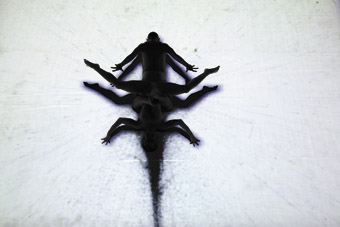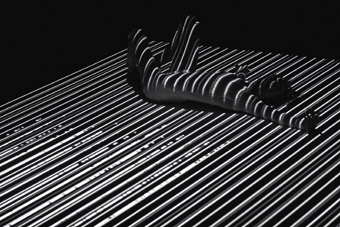after glow
keith gallasch talks with chunky move’s gideon obarzanek

Mortal Engine, Chunky Move
photo Rom Anthonis
Mortal Engine, Chunky Move
ONE OF THE MOST INNOVATIVE AUSTRALIAN PERFORMANCE WORKS OF RECENT TIMES, GLOW, WAS THE OUTCOME OF A COLLABORATION BETWEEN CHUNKY MOVE ARTISTIC DIRECTOR GIDEON OBARZANEK AND GERMAN INTERACTIVE VIDEO SYSTEMS MAKER FRIEDER WEISS. AFTER PREMIERING IN MELBOURNE AND SUCCESSFULLY TOURING TO THE SYDNEY OPERA HOUSE STUDIO, GLOW IS FEATURED IN THIS YEAR’S MELBOURNE INTERNATIONAL ARTS FESTIVAL. AFTER THAT, IT’S OFF TO VANCOUVER’S PUSH INTERNATIONAL PERFORMANCE FESTIVAL, NEW YORK’S THE KITCHEN (IN PARTNERSHIP WITH PS21 AND THE JOYCE THEATRE) AND LONDON’S SOUTHBANK HAYWARD GALLERY. IN THE MEANTIME, A NEW WORK, AN EVOLUTIONARY STEP ON FROM GLOW IS ALREADY IN DEVELOPMENT FOR AN EARLY 2008 PREMIERE.
In Glow, the audience look down from all sides of the theatre onto a white floor-cum-screen on which a dancer generates an animated environment, initially taut and geometric and then ominously impressionistic. The performer appears to evolve from a huddled form into human shape, creating a world of astonishing shapes and colours around her, one which eventually takes on a threatening life of its own. It’s an intense experience and, dark as its theme appears to be, an exhilarating one, the thrill not simply at the technological magic but in its meaningful integration.
It seems long ago that laser-driven interactivity offered an apparently unique potential for performers to drive their own lighting and sound effects, but it rarely came to much. However, using instead interactive video systems developed by Frieder Weiss with his Calypso software, Glow effectively and convincingly realises the dream. Now, in a new work, Mortal Engine, Obarzanek and Weiss come together again, but this time with Melbourne-based sound artist Robin Fox on oscilloscope and sound and, yes, adding lasers.
For Obarzanek, lasers offer “a way of getting off the screen into the volume of the space, including above the audience in the auditorium.” As well Weiss has got the video and laser systems speaking to each other. The advantage of the laser system is that, as well as being responsive to sounds, it can track more bodies than Glow’s one dancer, allowing Obarzanek a cast of six.
Obarzanek says that for Robin Fox it’s a return to working with the oscilloscope (his recent focus has been on lasers) here projected onto the screen floor, following a dancer (thanks to an algorithm created in Weiss’ Calypso) as well as responding to sound files, as it has done in Fox’s powerful sound art works. Both Weiss and Fox will work live in Mortal Engine, meaning that visuals and sounds can change performance to performance. The company will skill up a trainee in the technology for subsequent seasons.

Kristy Ayer, Glow, Chunky Move
photo Andrew Curtin
Kristy Ayer, Glow, Chunky Move
Compared with Glow, there is an exponential growth in realtime interactivity and its variables in Mortal Engine. Towards the end of Glow, Obarzanek says, the graphics, in relationship to the performer’s body, had become semi-autonomous. He and Weiss wanted to go past the “quite straightforward” approach of Glow to a point where the environment in Mortal Engine, he stresses, “will most certainly have a life of its own.”
Mortal Engine will also be a longer work, 60 minutes to Glow’s 26, but not all of it technologically governed and not all danced. There will be passages created with the dancers where the video-laser system will be in ‘off’ mode and another in which Robin Fox will project his oscilloscope onto a stage emptied of dancers and filled with sound.
Again, the stage floor will also serve as a screen, but given the considerable challenges Glow offered presenting venues (many theatres find it hard to provide the audience overview and some have had to build the appropriate banks of seating), Obarzanek has opted for a raked floor that can be deployed on a conventional stage. Given what he describes as his “aversion to vertical screens”, the rake seems a good solution, especially when complemented with the overhead possibilities provided by lasers. The rake also has panels that unfold from the floor. The design is by Obarzanek working with the company’s production manager Richard Dinnen, the music by Iceland-based Australian composer Ben Frost.
Obarzanek’s vision seems to have a distinctive if lateral cinematic dimension—integrating the screen into his performance spaces in Glow and the forthcoming Mortal Engine, but also in making films. His first venture was a dance film for the ABC, Wet (1998), which he thinks he “took on far too early” and which “made him shy of film.” However, at this year’s Melbourne International Film Festival his 10-minute Dance Like your Old Man (2007) won Best Short Documentary against international competitors and the Nova Award for Innovative Australian Cinema. In the film women dance like their fathers while describing their relationships with them. Obarzanek recalls feeling “thrilled and shocked” about winning “because the film was so simple. I generally have an aversion to dance on film, but that makes it a challenge to do it.”
What particulary pleased Obarzanek was being rewarded for making a documentary. It’s what he’s been doing on stage, he says, in works like the poll data-driven Wanted: Ballet for a Contemporary Democracy (2002) and the interview based I Want to Dance Better at Parties (2004) which features men talking about themselves and dance). He suspects that the effectiveness of Dance Like Your Old Man comes from the tension between the images of the women dancing, on the one hand, and, on the other, what they say about their fathers: “it’s more complex, more difficult”, whereas “the dancing is cute but quickly runs out without the words.”
With the fellow creators of the celebrated Tense Dave (2003)—Lucy Guerin and Michael Kantor—Obarzabek shares another aversion, to dance theatre: “We like the idea but we don’t think it works.” But as with dance film, it’s something to take on, now for a second time. The low tech Tense Dave used a giddying stage revolve to great effect, constantly and magically, even cinematically, reframing action and images with limited means. The new work, Two-Faced Bastard, with the same team, is already in the making; “even more low tech, almost no costuming, strong performers and performed to two fronts. Two shows are presented at the same time separated by a curtain with the performers slipping through it from one show to the other. It’s a challenge because you can always hear what’s happening in the other show.” We can look forward to some more theatre magic and, doubtless, as in Tense Dave, Glow and Mortal Engine, human wilfullness tangling with an environment (low tech or high) that appears to have a life of its own.
Chunky Move is in full touring mode: I Want to Dance Better at Parties is soon off to Pittsburgh after a five city tour in the USA and to Vancouver and Christchurch earlier this year; and Glow has been to Sydney and Darwin, the Netherlands and soon travels to Beijing, Shanghai, Dresden and Perth before going on to the USA and UK. Obarzanek has no doubt that the company’s new works, Mortal Engine and Two-Faced Bastard, will provide major opportunities for international touring. Chunky Move will continue to take Australian performance innovation to the world—and in Glow and Mortal Engine, innovation born of Australian and German invention.






